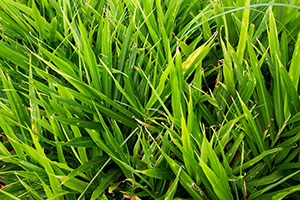Edible Ginger

Ginger is a perennial plant that’s been grown for centuries all over the world. Today it is still used culinary and medicinally. Edible ginger root can be bought fresh by the pound, or in a powdered or candied form.
Ginger is one of our favorite plants to include in a foodscape or edible garden. The leafy, grassy foliage adds a tropical backdrop for more colorful plants. It grows well throughout the state, too, as long as the soil is amended with organic matter. And for gardeners with tree-covered landscapes, ginger is one of the few crops that loves some shade.
Characteristics
While ornamental gingers come in all colors, shapes, and sizes, edible ginger is generally grown for its root. Zingiber officinale has narrow leaf blades and reaches only 2-3 feet tall. The foliage is bright green and lush. In autumn, mature plants produce flower spikes with yellow-green, pink, or purple-tipped flowers.
Edible ginger is best known for its underground stems, or rhizomes. This is the part of the plant that produces the “ginger” spice we love. The rhizomes are plump and tan, growing a few inches below the soil. When cut they smell pungent and spicy.
Planting and Care
Plant edible ginger in the spring once the danger of frost is past but before the weather heats up. In North Florida, plant starting in March. In Central and South Florida, plant as early as February.

Zingiber officinale is not grown from seed. Instead, sellers stock ginger “seed” rhizomes, pieces of the rhizome from which ginger can sprout and expand. For smaller plantings you could even start with fresh ginger root purchased from your local supermarket.
Soil preparation is key to a productive ginger crop. Create a bed of well-drained soil that’s been prepared with organic matter. An even mixture of sand and cow manure (or other suitable organic mixture) is a good, rich mix for ginger. On rockland soil, try growing ginger in a raised bed with a soil mixture at least 8 inches deep. Zingiber officinale is also an excellent choice for container gardening.
Plant 1 to 1.5-inch pieces of rhizome about an inch below the soil line. If you cut one larger rhizome apart for planting, let the pieces dry indoors for a few days to prevent rotting. Space pieces about 15 inches apart as the underground structure will expand over the course of the year. After the ginger is planted, keep the soil moist for a few weeks until sprouts emerge.
Edible ginger does best in partial shade. It produces well if it gets a couple hours of sunlight a day but will grow in full shade, too. More than a couple hours in the sun is too much; the plants will grow poorly and the leaves will turn brown at the tips.
Ginger is considered a long-season crop and takes about eight to ten months to produce fully developed rhizomes. Harvest mature ginger in the fall or when the tops have died back. Allow the rhizomes to dry in the shade before processing them further. Once the skin dries you can store them in the fridge or keep them in your freezer, thawing them as needed. You can also harvest ginger early, just before flower spikes emerge. Young ginger does not need to be peeled, and the taste is milder. This preparation of ginger is popular in Asian markets.
To enjoy ginger again next year, thin your ginger plants rather than harvesting the entire crop. The rhizomes should produce sprouts again as the weathers warms in the spring. In areas that experience hard freezes you may wish to cover the area with a layer of mulch, or grow your ginger in containers. These plants experience few pests and diseases.

For more information on ginger and foodscaping, contact your county Extension office.
